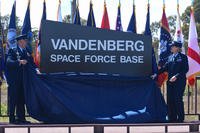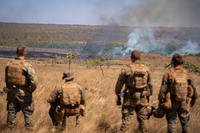HONOLULU – Crews from the Coast Guard, National Oceanic and Atmospheric Administration, and the State of Hawaii's Division of Conservation and Resources Enforcement, from the Department of Land and Natural Resources are partnering together to protect humpback whales as they make their annual migration to Hawaiian waters.
Humpback whale season is generally from November to May with the peak season occurring during the months of January and March. According to the Hawaiian Islands Humpback Whale Marine National Sanctuary, whales come to the Hawaiian Islands to mate, calve, and nurse their young. They return to Alaska in the summer months because Hawaii's waters are relatively nutrient-free and too warm to support enough of the humpback's food to sustain them year-round. The whales must migrate back to colder water to feed and rebuild their blubber supply.
"It is certainly beneficial to have the Coast Guard, NOAA and DOCARE working together with the same goal of protecting these marine mammals,” said Eric Roberts, the 14th Coast Guard District’s marine mammal response manager. “By combining our resources, we are better prepared to protect this endangered species in a way that helps keep both the animals and Hawaii’s mariners safe.”
The 14th Coast Guard District is home to four marine national monuments and two national marine sanctuaries, more than any other region in the United States. Since the 2009-2010 humpback whale season, the Coast Guard has been conducting Operation Kohola Guardian, a program created to formalize the Coast Guard's protection of the endangered humpback whale.
Operation Kohola Guardian involves coordinated joint Coast Guard, NOAA and DOCARE patrols of the sanctuary during the peak months of January through March. The Coast Guard aims to protect both the safety of mariners as well as the endangered humpback whales while in the sanctuary by direct communication with boaters.
“We are so fortunate to have the humpbacks visit Hawaii each year,” said Elia Herman, sanctuary co-manager with the DLNR. “But with that comes added responsibility – and we all need to continue to work together to ensure the laws are followed and both whales and people are protected.”
There are several whale collisions near the Hawaiian Islands every year. Boaters can take proactive measures to ensure their safety as well as the safety of the whales. Keeping a boat's speed down when whales are known to be in the area is one step mariners can take. Mariners should also maintain a sharp lookout at all times.
Weighing an average of 45 tons, a humpback whale collision with a mariner can be catastrophic. While on routine patrol, Coast Guard boats and air crews scan the area for signs of whales. If whales are sighted crews alert nearby mariners to ensure they remain away. It is illegal to approach within 100 yards of a whale. Aircraft are also prohibited from flying within 1,000 feet of a whale.
"Protecting humpback whales in Hawaii requires the work of multiple agencies. The Coast Guard, NOAA and the state of Hawaii's DOCARE all play important roles, that when combined, result in better protection for whales in the Hawaiian Islands Humpback Whale National Marine Sanctuary," said Sanctuary Superintendent Malia Chow, from NOAA. "It is truly a multi-agency effort."
Coast Guard crews conduct sanctuary patrols to ensure boaters and marine life stay safe.
"One of our core missions is the protection of marine mammals, so it's crucial that we work closely with our federal, state and local partners to ensure that the maritime community is respecting our maritime laws," said Roberts. "By partnering with NOAA and DOCARE, we've been able to increase our presence throughout the Sanctuary.”
The Coast Guard's efforts to protect humpback whales are not limited to surface patrols. Coast Guardsmen act as first responders to entanglements and other marine mammal distress calls, and they are often the reporting source to NOAA and DOCARE. While on routine patrols, Coast Guard rescue helicopter crews from Air Station Barbers Point sometimes spot distressed marine mammals.
“Coast Guardsmen attend regular training focusing on large whale entanglement response and we are permitted to act on behalf of NOAA in certain circumstances,” Roberts said. “This provides our members with the technical knowledge to assess the extent of the entanglements and attached satellite tracking gear as needed. Additionally, our boat operators receive extensive training on safe approach techniques to limit the risks to both the animals and our response personnel.”
The Coast Guard assists with an average of 12 to 15 whale entanglements each season and transports numerous marine mammals that are in danger to safer locations.
Mariners and citizens are asked to report injured or entangled marine mammals to the Coast Guard on VHF marine band channel 16, or at 808-842-2600, or by contacting the NOAA fisheries hotline at 800-853-1964.

























